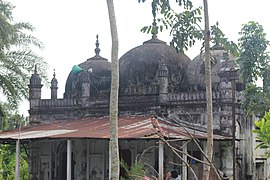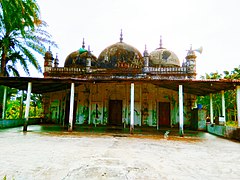Ramadan Miah Mosque
This article needs additional citations for verification. (December 2019) |
| Ramadan Miah Jame Mosque | |
|---|---|
রমজান মিয়া জামে মসজিদ | |
 | |
| Religion | |
| Affiliation | Islam |
| Branch/tradition | Sunni |
| Leadership | Khwaja Mu'in ad-Din Chowdhury |
| Year consecrated | 1770 |
| Status | active |
| Location | |
| Location | Kabirhat, Noakhali District, Bangladesh |
| Architecture | |
| Architect(s) | Ramadan Miah |
| Type | Mosque |
| Style | Islamic architecture |
| Date established | 1770 |
| Groundbreaking | 1770 |
| Completed | 1770 |
| Specifications | |
| Capacity | 600 |
| Materials | Brick |
Ramadan Miah Jame Mosque, or Ramzan Mia Jame Masjid (Bengali: রমজান মিয়া জামে মসজিদ, Arabic: مسجد رمضان میاه), and more popularly known as Chowdhury Mosjid (Bengali: চৌধুরী মসজিদ), is a mosque in the Noakhali District of Bangladesh. The existence of such an ancient mosque was not widely known to the general public until it was brought forward to Kabirhat's upazila nirbahi officer, Shariful Islam.[1]
Location
The mosque can be found in the village of Daulat Ramdi, located in Kabirhat Upazila's No. 7 Bataiya Union Parishad.[2]
History
The three-domed mosque was built during the Mughal Era and is over 300 years old.[3] It was established by Shaykh Noor Ullah Chowdhury and Shaykh Mujeer Ullah Chowdhury, the ancestors of the current chairman of the mosque, Khwaja Mu'in ad-Din Chowdhury.[1]
Gallery
-
The upper part of the mosque.
References
- ^ a b Ghulam Muhiuddin Nosu (5 December 2016). রমজান মিয়া জামে মসজিদ. Samakal (in Bengali).
- ^ রমজান মিয়া জামে মসজিদ. Kabirhat Upazila (in Bengali).
- ^ কবিরহাটে ৩০০ বছরের পুরোনো মসজিদ (in Bengali).



